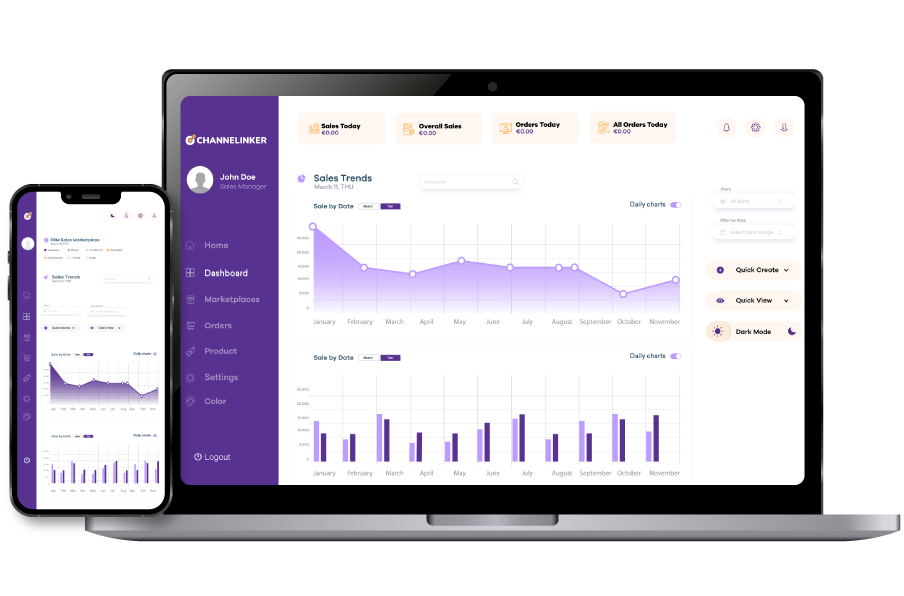Understanding the Amazon Marketplace 2025 Edition

Introduction
Amazon Marketplace remains at the forefront of global e-commerce in 2025. It now connects millions of sellers and buyers, providing an unprecedented opportunity for businesses and entrepreneurs worldwide. Recent data shows there are more than 9.7 million registered sellers, with about 2.5 million active at any given time (Forceget, 2025). Independent sellers account for over 60 percent of total sales on the platform, which highlights Amazon’s ongoing commitment to fostering entrepreneurial growth.
Marketplace managers, e-commerce store owners, FBA sellers, CTOs, and operations teams benefit from staying updated on Amazon’s evolving landscape. This guide reflects the latest changes, statistics, and strategies you need to stay competitive in 2025.
What is the Amazon Marketplace?
Amazon Marketplace is an online selling platform where businesses of every size can list their products and connect with a global audience. Sellers leverage Amazon’s vast traffic, marketing tools, and fulfillment options. Buyers gain access to extensive product variety, competitive prices, and the assurance of Amazon’s trusted shopping experience. According to JungleScout’s 2025 Amazon Seller Report, the marketplace sees about 12 million orders each day across the world.
For sellers, the platform provides an instant opportunity to reach customers beyond their local markets. Amazon’s fulfillment infrastructure, payment processing, and customer service systems are all designed to help sellers grow without needing to build or maintain their own e-commerce platform.
Types of Sellers and Buyer Behavior
Amazon is home to a diverse community of sellers. These range from individual entrepreneurs offering a handful of products to small and medium businesses looking to grow internationally. Larger brands and manufacturers use Amazon to supplement their direct-to-consumer sales channels. Agencies and professional marketplace managers often oversee multiple brands under one account.
Buyers expect reliability, value, and prompt service. Many shoppers compare multiple sellers for the same product and rely heavily on reviews. Fast shipping and responsive customer service are key factors that influence purchase decisions. Sellers who consistently meet these expectations have a better chance of winning the Buy Box, which is the primary purchase option displayed to customers.
Market Size and Seller Performance
Amazon reported revenue of about 638 billion dollars for 2024, with forecasts for 2025 reaching nearly 700 billion dollars (Analyzer Tools, 2025). Marketplace seller gross merchandise value was around 480 billion dollars in 2023, representing approximately 75 percent of Amazon’s total net sales (CapitalOneShopping, 2025). In 2023, the average active seller made roughly 250,000 dollars and about 1.9 million sellers completed at least one sale during the year. More than half of new sellers become profitable within their first twelve months on the platform (Forceget, 2025).
Amazon’s Fee Structure
In 2025, Amazon has announced that referral and FBA fees will remain stable and, in some cases, have even been reduced for certain categories and large products (Amazon Selling Partner News, 2025). Here are the primary fees sellers can expect:
Referral fees are charged on each sale and typically range from six percent to forty-five percent depending on the product category. The minimum referral fee is usually around thirty cents per item.
FBA fees cover storage, picking, packing, shipping, and customer returns. These costs depend on product size, weight, and storage duration.
Professional sellers pay a monthly subscription fee, usually thirty-nine ninety-nine dollars, for access to advanced tools and bulk listing capabilities. Individual sellers pay a small fee per transaction instead.
Other fees may include long-term storage, advertising for sponsored products, refund administration, and high-volume listing charges. Sellers are encouraged to use Amazon’s fee calculators and check Seller Central regularly for updates and detailed breakdowns by product and marketplace.
Marketplace Policies and Regulations
Amazon maintains strict seller policies in order to protect customers and the integrity of its platform. In 2025, compliance is more important than ever. Selling counterfeit products, listing inaccuracies, or repeated late shipments can quickly result in account suspensions. Around 62 percent of all Q4 2024 sales came from third-party sellers, highlighting the importance of policy compliance for continued marketplace success (RepricerExpress, 2025).
Sellers must ensure that product information is accurate, items are shipped promptly, and all regional laws and tax requirements are met. Staying informed about Amazon’s policy updates and regularly monitoring account health through Seller Central is essential.
New Developments for 2025: Project Starfish
This year, Amazon introduced Project Starfish, a significant AI initiative designed to improve product data accuracy and automate richer, more detailed listings. Early estimates project that Project Starfish will contribute about 7.5 billion dollars in additional gross merchandise value by the end of the year (Business Insider, 2025). With these AI-powered enhancements, sellers benefit from automated product titles, improved descriptions, more compelling images, and better-targeted ads, all with less manual effort.
Key Terminology
Here are a few essential terms every seller should know:
ASIN is the unique code that identifies each product on Amazon
Buy Box is the main purchase option displayed to buyers on a product page
FBA or Fulfillment by Amazon means Amazon handles storage, shipping, and customer service for your inventory
Seller Central is the dashboard for managing inventory, orders, and account health
A-to-Z Guarantee is Amazon’s buyer protection program that encourages trust and satisfaction
Frequently Asked Questions
How many active sellers are there in 2025?
There are more than 9.7 million registered sellers and about 2.5 million active ones.
What is the average revenue for active sellers?
In 2023, average seller revenue was around 250,000 dollars.
Are Amazon’s fees going up in 2025?
No, most fees remain stable or have been reduced for select categories.
What is Project Starfish?
Project Starfish is Amazon’s latest AI upgrade to improve product listings and data accuracy, projected to add 7.5 billion dollars in sales this year.
What happens if a seller violates Amazon’s policies?
Amazon may suspend or permanently remove a seller’s account for repeated violations, inaccurate listings, or counterfeit products.
Conclusion and Next Steps
Amazon Marketplace in 2025 continues to expand and innovate. Sellers are benefiting from stable fees, improved AI-driven tools, and an ever-growing customer base. To thrive on the platform, sellers should focus on creating accurate listings, monitoring performance metrics, and taking advantage of Amazon’s new features. Integration platforms like Channelinker are valuable for managing inventory, syncing data, and streamlining operations across multiple sales channels.
For more information, visit our guides on advertising, fee management, and AI-powered listing tools. If you are interested in automating your marketplace management, request a demo from the Channelinker team.


